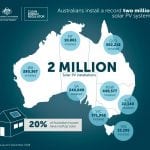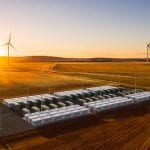Around The Web
COP24: Asian Development Bank launches ITMO pilot support for SE Asia
A Big Country 8 December 2018
Nasa's InSight probe listens to Martian winds
EEX announces 2019 EUA, EUAA auction calendars for EU group of 25
Any Trump infrastructure deal must tackle climate change, Democrats warn
- Trump seeking $1bn package to upgrade road, rail and bridges
- Senator Chuck Schumer issues condition for Democrat support
Democrats will only support an infrastructure deal with Donald Trump if it includes measures to combat climate change, the Senate minority leader, Chuck Schumer, has warned.
In an op-ed in the Washington Post and a letter to Trump, the New York Democrat said that his party “will have an extraordinary opportunity to force action on climate change” after taking control of the House of Representatives in the recent midterm elections.
Continue reading...RGGI auction clears at $5.35, continuing streak of above-market results
The week in wildlife – in pictures
An African wild dog preparing for a hunt and a male mimic poison frog transporting a tadpole are among this week’s pick of images from the natural world
Continue reading...UK children face winter health crisis due to pollution, say doctors
Toxic air and cold weather could create deadly conditions and stretch NHS, medics say
Thousands of children are facing hospital this winter as cold weather and the UK’s air pollution crisis combine to create potentially deadly conditions for young people, doctors have warned.
The Royal College of Paediatricians, the Royal College of Physicians and children’s charity Unicef say that the UK’s toxic air and cold weather will leave a huge number of children extremely vulnerable this winter, creating an “overlooked” emergency for an already stretched NHS.
Continue reading...Chang'e-4: China mission targets Moon's far side
Deadly pig virus could hit US in a year, warn experts
African swine fever has been spreading rapidly in China and has also travelled from Russia and Eastern Europe to Belgium. Experts fear it is only a matter of time before it reaches the US.
A global outbreak of African swine fever will reach the US within a year unless border protections are tightened and imports of high-risk pork products banned, warn biosecurity experts. It would cost the US economy $16.5bn (£12.9bn) in the first year alone, it has been estimated.
An ongoing epidemic of the virus, which is deadly for pigs but cannot yet be transmitted to humans, has prompted the US Department of Agriculture to review and strengthen its border protections. After outbreaks in Belgium and China this year, the USDA has increased the use of sniffer dogs at major ports, airports, land borders crossings, and has also built quarantine stations and increased passenger and cargo inspections on flights from China and Russia, the worst hit countries.
Continue reading...Bloodhound supersonic car project axed
World's oldest known wild bird to become a mother for the 37th time
Wisdom, a 68-year-old Laysan albatross, has laid another egg with her longtime lover at the Midway Atoll national wildlife refuge
In sea mariner lore, an albatross is considered a good omen, and for almost seven decades, one bird has spread generations of blessings across the Pacific Ocean.
Wisdom, a 68-year-old Laysan albatross believed to be the world’s oldest known wild bird, has returned to her home at the Midway Atoll national wildlife refuge for yet another winter – and laid yet another egg to add to the already impressive brood that she has built up over an impressive lifetime.
Continue reading...Africa cocoa industry failing on deforestation pledge – campaigners
Tens of thousands of hectares cleared in Ghana and Ivory Coast since vow to end practice
The cocoa industry is failing to meet a highly publicised pledge to stop deforestation in west Africa and eliminate tainted beans from supply chains, environmental campaigners say.
Big chocolate companies and the governments of Ghana and the Ivory Coast continue to be responsible for the deforestation of tens of thousands of hectares of land over the past year in former rainforest-covered nations, despite their solemn promises to end the practice last November, the campaigning organisation Mighty Earth said.
Continue reading...Graph of the Day: Breakdown of Australia’s two million solar homes
 A state-by-state breakdown of the two million homes and businesses that now have rooftop solar.
A state-by-state breakdown of the two million homes and businesses that now have rooftop solar.
The post Graph of the Day: Breakdown of Australia’s two million solar homes appeared first on RenewEconomy.
Deep dive into first year of Tesla big battery at Hornsdale
 Gluttony and stupidity. The response from government and incumbents to the role of Tesla big battery has verged on distortion and stupidity. Here are a few facts, and graphs, to correct the record.
Gluttony and stupidity. The response from government and incumbents to the role of Tesla big battery has verged on distortion and stupidity. Here are a few facts, and graphs, to correct the record.
The post Deep dive into first year of Tesla big battery at Hornsdale appeared first on RenewEconomy.
Engie signs deal to make Queensland’s Greater Springfield a net-zero city
 Engie has signed a 50-year strategic alliance with Queensland’s Springfield City Group to make the city a net-zero energy city.
Engie has signed a 50-year strategic alliance with Queensland’s Springfield City Group to make the city a net-zero energy city.
The post Engie signs deal to make Queensland’s Greater Springfield a net-zero city appeared first on RenewEconomy.
Sonnen, Tiko virtual power plant allows consumers to displace conventional power plants
 Sonnen and Tiko combine to use household batteries to provide primary balancing power for German network, meaning consumers can perform the tasks of big conventional power plants.
Sonnen and Tiko combine to use household batteries to provide primary balancing power for German network, meaning consumers can perform the tasks of big conventional power plants.
The post Sonnen, Tiko virtual power plant allows consumers to displace conventional power plants appeared first on RenewEconomy.
Test Drive: Hyundai Ioniq and the “new normal” in electric cars
 Hyundai has made every effort to make its Ioniq electric vehicle range look normal or average. The driving experience is anything but.
Hyundai has made every effort to make its Ioniq electric vehicle range look normal or average. The driving experience is anything but.
The post Test Drive: Hyundai Ioniq and the “new normal” in electric cars appeared first on RenewEconomy.
Scientists say most diverse coral site ever seen on Great Barrier Reef discovered
In a space no longer than 500 metres, researchers say they recorded at least 195 different species of corals
A team of researchers says it has discovered the most diverse coral site ever recorded on the Great Barrier Reef.
Great Barrier Reef Legacy, a non-profit organisation that conducts research trips on the reef, and scientist Charlie Veron, known as the godfather of coral, have identified the site on the outer reef.
Continue reading...Test drive: Jaguar I-Pace, electric heaven
 After a lifelong love of Jaguars, RE got to test drive the newly released, fully electric i-Pace. And, well, wow. ...Is it better than a Tesla Model S?
After a lifelong love of Jaguars, RE got to test drive the newly released, fully electric i-Pace. And, well, wow. ...Is it better than a Tesla Model S?
The post Test drive: Jaguar I-Pace, electric heaven appeared first on RenewEconomy.



